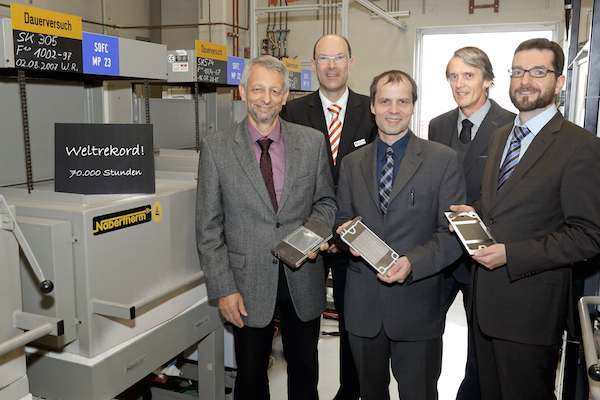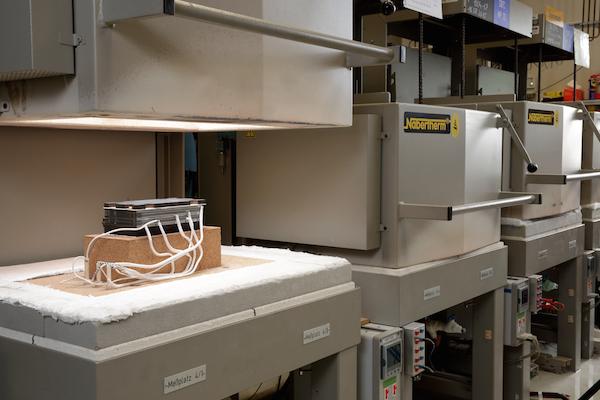
[Image above] Jülich scientists responsible for the record accomplishment (from left): Prof. Ludger Blum, Dr. Norbert H. Menzler, Dr. Jürgen Malzbender, Dr. Bert de Haart, and Dipl.-Ing. Margaritis Nikolaos. Credit: Forschungszentrum Jülich
If you like to talk about the weather, there’s been a lot to talk about lately—extreme weather patterns are trending upwards, according to data from the National Oceanic and Atmospheric Administration.
Although nothing as huge as worldwide climate patterns are ever certain, there is strong evidence that climate change is behind at least some of the weird weather extremes.
There’s no denying that human action is changing our planet. Those actions are having consequences beyond the atmosphere, too, indicating just how much humans are changing the planet for all its inhabitants.
World leaders are currently leading some difficult discussions about what to do about climate change in Paris, but change isn’t limited to the big guys—we each can have a small part to make our burgeoning society less stressful on the planet. How small? New research suggests that making the switch to energy-efficient LED lights tops the list of everyday ways to fight climate change.
In fact, many of you reading this are probably doing more than making small changes—some of you are leading the groundbreaking research on new energy technologies that will diminish society’s old polluting ways.
As we’ve said before, fuel cells are one of those technologies that offer a lot of hope for a clean energy future. Lately, fuel cells have been making a splash in the automotive world and beyond. In fact, after decades of advancement on the fuel cell front, “many signs indicate that the fuel cell industry is reaching its tipping point,” according to a Product Design & Development article.
Fuel cells come in a variety of flavors, but one of the most promising is the solid oxide fuel cell, or SOFC. Despite significant advancements in the materials and technology behind SOFCs—including Colorado School of Mines’ BZY membrane-containing protonic ceramic cell)—fuel cells are expensive. So costly, in fact, that experts say that individual fuel cells need to be able to run continuously for ~5–10 years to be economically viable.
If that can happen, SOFCs could become significant energy- and emission-saving technologies for use in residential applications, supplying electricity and hot water to households efficiently and easily.
Researchers at Forschungszentrum Jülich research center (Jülich, Germany) have made a significant advance in that direction—they have set a world record for the longest continually-running SOFC, a major achievement for fuel cells everywhere.
The Jülich fuel cell began its turtle-paced experiment on August 6, 2007, and has been running ever since. That’s longer than 8 years, or more than 70,000 hours, of runtime.
Siemens Westinghouse Power Corporation held the previous world record with its tubular ceramic fuel cell, which ran for a continuous 69,000 hours. Instead of tubular, the Jülich cell is flat, providing lower internal resistance that allows higher power density at reduced temperatures, according to Jülich press release. (If you can read German, the full release is here.)

SOFC fuel cell stack in test operation at Forschungszentrum Jülich. Credit: Forschungszentrum Jülich
Like most SOFCs, the Jülich-developed cell runs off hydrogen, but can also adapt to methane fuel sources. According to the release, the cell’s continuous operation has used that fuel to generate 3,400 kilowatt hours of electricity, “enough to supply a household with electricity for a year.”
High-temperature fuel cells such as the Jülich cell can deliver high electrical efficiencies of up to 60%, but, to do that, the cells heat up to temperatures of around 700°C. So, to continually withstand that heat, the cells’ materials must be chosen carefully—luckily, ceramics just happen to be the perfect materials for such a demanding environment.
The Jülich researchers used their more than 20 years of SOFC research experience to innovate their record-breaking fuel cell. Jülich holds 95 patents for SOFC components, so it’s no surprise that many of the cell’s components were developed in house. “These include the ceramic cells, the contact layers, and a special glass-ceramic that is used because of the high temperatures for sealing,” according to the release. One exception is the stack’s intermediate plate material, which was developed by Plansee SE (Reutte, Austria).
Although SOFCs can theoretically run as long as fuel is supplied, the cells age with time—their materials degrade with continual cycling, decreasing performance. This informs the challenge of maintaining a fuel cell for 5–10 years of runtime, the cutoff to make the technology economically viable. Significant aging of fuel cells can prohibit the units from reaching that target time.
Measurement of the Jülich cell put its aging rate at just ~0.6% per 1,000 hours of operation. But, the researchers say they can do much better—the team refined its fuel cell stack after the initial experiment was launched in 2007. That new fuel cell formulation began its own trial run in 2010. Researchers say the refined stack, after ~34,500 hours, has aged only half as fast as the record-breaking cell, indicating even more hope for the future of fuel cells.
